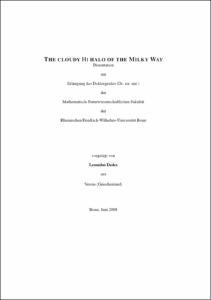The cloudy HI halo of the Milky Way

The cloudy HI halo of the Milky Way

| dc.contributor.advisor | Kerp, Jürgen | |
| dc.contributor.author | Dedes, Leonidas | |
| dc.date.accessioned | 2020-04-12T18:39:59Z | |
| dc.date.available | 2020-04-12T18:39:59Z | |
| dc.date.issued | 2008 | |
| dc.identifier.uri | https://hdl.handle.net/20.500.11811/3693 | |
| dc.description.abstract | Based on the analysis of the Milky Way soft X-ray background and all sky 21-cm line surveys models show that the gaseous Galactic Halo has two components, one of hot plasma with log[T(K)]=6 and a neutral component. If pressure equilibrium exist between the two phases, the neutral layer must exhibit extensive small scale structure. The first direct evidence of the clumpy nature of the neutral component was the observation of a population of neutral halo clouds in the inner Galaxy with the GBT telescope (Lockman, 2002). A study of these clouds can help us infer the properties and physical condition of the gaseous Galactic halo. The main purpose of my thesis was to build and study a sample of co-rotating neutral halo clouds located outside the solar circle. The Bonn Milky Way mass model and the Leiden/Argentinian/Bonn (LAB) all sky 21-cm survey were used to select 23 appropriate regions for observation. The observations were contacted using the Effelsberg 100-m telescope for 22 regions and the Arecibo 300-m telescope for one region. Additionally, using two interferometers, high resolution observations of two clouds from the Effelsberg sample were done. The Effelsberg observations detected a population of clouds which show a striking two component structure, a cold narrow component (cloud) and an extended warm component (envelope). These clouds were over-pressured and not virialised. The interferometer observations showed that the neutral halo clouds are resolved into arc-minute sized cores which are in pressure equilibrium with the surrounding extended envelope. Their angular size implies spatial sizes of the order of pc. The Arecibo observations showed a clearer picture, since they detected clouds with properties similar to the interferometer cores, but also traced the presence of the extended component. The samples of halo clouds/cores were compared with theoretical phase diagrams (Wolfire et al., 2003) to test the possibility of thermal equilibrium between the clouds and the extended envelope. The Effelsberg sample did not match the theoretical predictions, an effect that is likely caused by insufficient beam resolution. The Arecibo and the interferometer samples found that the halo clouds lay either in the phase transition region or in the region where cold neutral gas is allowed to exist in stability. This implies that thermal equilibrium between the warm extended phase and the clouds is possible. The Arecibo and Effelsberg samples were used to test the Galactic Fountain paradigm as a formation mechanism for the halo clouds. The observable kinematic properties of the sample were compared with the results of a simple toy model of ballistic motion. The comparison shows that the motion of 50% of the clouds could be a product of a Galactic fountain. The large area observed with the Arecibo telescope was used to study the turbulence in the neutral medium at different distances. Using a power spectrum analysis, the gas associated with the disk shows a Kolmogorov index. Gas with velocities associated with the gaseous halo shows a shallower index which implies the presence of more small scale structure. Finally, a small part of the thesis was dedicated to try to understand the effect of the spiral structure on the Galactic velocity field. Utilizing the linear density wave theory, spiral structure was implemented in the Bonn Milky Way mass model. The results were image cubes of synthetic line data which were compared with real data from the LAB 21-cm line all sky survey. | en |
| dc.language.iso | eng | |
| dc.rights | In Copyright | |
| dc.rights.uri | http://rightsstatements.org/vocab/InC/1.0/ | |
| dc.subject | Radioastronomie | |
| dc.subject | Milchstrasse | |
| dc.subject | HI | |
| dc.subject | Interstellares Medium | |
| dc.subject | Galaktischer Halo | |
| dc.subject | Radio astronomy | |
| dc.subject | Milky Way | |
| dc.subject | Interstellar Medium | |
| dc.subject | Galactic Halo | |
| dc.subject.ddc | 520 Astronomie, Kartografie | |
| dc.title | The cloudy HI halo of the Milky Way | |
| dc.type | Dissertation oder Habilitation | |
| dc.publisher.name | Universitäts- und Landesbibliothek Bonn | |
| dc.publisher.location | Bonn | |
| dc.rights.accessRights | openAccess | |
| dc.identifier.urn | https://nbn-resolving.org/urn:nbn:de:hbz:5N-15630 | |
| ulbbn.pubtype | Erstveröffentlichung | |
| ulbbnediss.affiliation.name | Rheinische Friedrich-Wilhelms-Universität Bonn | |
| ulbbnediss.affiliation.location | Bonn | |
| ulbbnediss.thesis.level | Dissertation | |
| ulbbnediss.dissID | 1563 | |
| ulbbnediss.date.accepted | 02.09.2008 | |
| ulbbnediss.fakultaet | Mathematisch-Naturwissenschaftliche Fakultät | |
| dc.contributor.coReferee | Klein, Ulrich |
Files in this item
This item appears in the following Collection(s)
-
E-Dissertationen (4368)




